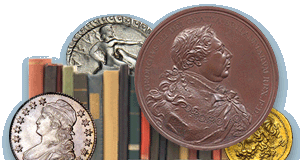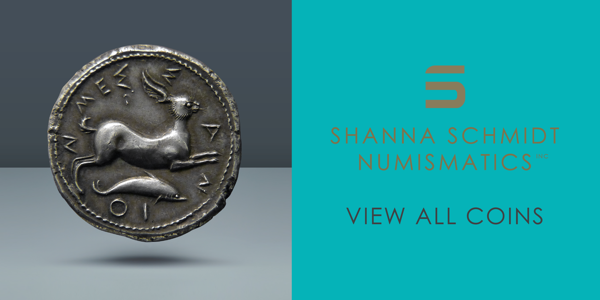
PREV ARTICLE
NEXT ARTICLE
FULL ISSUE
PREV FULL ISSUE
NUMISMAGRAM MEDAL SELECTIONS: FEBRUARY 9, 2025Numismagram's Jeremy Bostwick sent along these four medals from his upload of new medallic art to his site. For all of the new items, please visit https://www.numismagram.com/inventory. -Editor 102934 | FRANCE. Rouen. Church of St. Ouen bronze Medal. Issued 1859. Most Remarkable Edifices of Europe series (59mm, 12h). By Jacques Wiener in Brussels and struck at the Geerts mint in Ixelles. ST OUEN À ROUEN / GRAND PORTAIL ET LES 2 FLÈCHES PAR L'ARCHIT: GREGOIRE 1847–1850, exterior view of the church from the southwest // COMMENCÉE 1318 PAR L'ABBÉ JEAN ROUSSEL / ROSES DU TRANSSEPT 1439. LA NEF ACHEVÉE 1491. GRANDE ROSE DE LA FAÇADE 1515, interior view down the nave looking eastward toward the altar/apse. Ross M223 (R1); van Hoydonck 171; Reinecke 44. PCGS SP-64. Extremely glossy and brilliant, with alluring brown surfaces that are seemingly a bit more attractive than the near gem designation would otherwise indicate. Compare to a somewhat inferior example in Stack's Coin Galleries (18 August 2009), lot 6127 (which sold for a total of $402.50) and a similarly-graded example in Stack's Bowers CCO (2 March 2023), lot 71220 (which sold for a total of $600). $545. A former Benedictine monastic church, the current edifice was originally built as an abbey beginning in 1318, with completion coming some two centuries later due to cessations caused by the Hundred Years' War. Standing nearly 450 feet tall, its architectural style is a mix of Gothic and Flamboyant. From what is today eastern Netherlands and western Germany, the Wieners were a Jewish family of exceptional medalists, especially known for numerous numismatic works throughout the Kingdom of Belgium. Eldest brother Jacob (Jacques), along with younger brothers Leopold and Charles, created some of the finest works of medallic art of the 19th century, and all are particularly noted for their work in the highly detailed and intricate work of architectural renderings.
To read the complete item description, see:
102733 | FRANCE. Var. Contract Lawyers of Toulon octagonal silver Jeton. Issued circa late 19th century (30mm x 30mm, 13.26 g, 12h). Paris mint. LEX EST QUODCUMQUE NOTAMUS, two clasped right hands over radiant background // NOTAIRES / DE / L'ARRONDISSEMENT / DE / TOULON / (VAR) in six lines; all within garlanded wreath of oak and laurel branches. Edge: «cornucopia» ARGENT. Lerouge 399. PCGS MS-63. Mostly argent and highly brilliant, with some toning at the peripheries. The only such example of the type in the PCGS census. Ex Collection "PL." $295. Among the numerous jetons issued predominantly during the 18th and 19th centuries in France, certain professions tend to stand out. These jetons, dissimilar to their counterparts from prior centuries, which may have had some numismatic function as well as reckoning use, had far less utilitarian appeal. Instead, as James McClellan notes in his work, Old Regime France and its Jetons: Pointillist History and Numismatics, "...the historical and numismatic interest in jetons stems more from what else they became, particularly though the end of the eighteenth century under the Bourbon monarchs, as perks of office for office holders in the burgeoning nation state of France, New Year's Day presents exchanged among certain segments of society, and lagniappe handed out for attendance at meetings in town halls, regional estates, and learned societies. Jetons figured in the rites and rituals of the guilds and faculties; they were swag for general meetings of the clergy, and they served as calling cards for noble families. Decoding hidden messages became a parlor game for cognoscenti, and as "petit monuments" some jetons are miniature works of high art produced by the world's most talented artists/engravers at the world's preeminent mint." Here, the role of the "notaire" is mentioned, specifically for Toulon. While sometimes being translated as the English cognate "notary," the role of the "notaire" in France was, and is, much more involved. Essentially serving as a contract lawyer, the "notaire" deals in all facets of contracts in French life, most notably with wills, estates, and the sale of property. Given the omnipresent nature of such dealings in day-to-day life, it's not surprising how rampant the issuance of jetons for notaires was.
To read the complete item description, see:
103022 | GERMANY. Prisoners of War oval uniface cast bronze Medal. Issued 1914. "Kriegsgefangene" (66mm x 64mm, 68.40 g). By Ludwig Gies for Carl Poellath in Schrobenhausen. German soldier to far right, holding bayonet over shoulder and leading various prisoners of war by rope: French, Russian, Belgian, English, Serbian, and North African // Blank. Edge: C. POELLATH SCHROBENHAUSEN. Klose 16.1; The Art of Devastation –; Frankenhuis 1374; Ernsting 62. Essentially as Made. Deep brown in hue, with a charming light matte nature to the surfaces and just a minor degree of rub across the high points. A tremendous example of this very rare "imprisonment" type from the early period of the war. Ex David B. Simpson Collection. $795. On this otherwise unentitled work, Gies relies upon caricature to present the various enemies of Germany. For the most part, attire indicates the country of origin of each captive, though the one towering prisoner would appear to be an allusion to Belgium, given the taller (6'3") stature of King Albert—quite sizable when compared to other monarchs of the era.
To read the complete item description, see:
102830 | GERMANY. Ferdinand Adolf Heinrich August Graf von Zeppelin and Hugo Eckener silver Medal. Issued 1928. Commemorating the Airship LZ 127 Graf Zeppelin (36mm, 24.92 g, 12h). By Josef Bernhart at the München mint. GRAF ZEPPELIN • DR HUGO ECKENER / 1898–1928, jugate busts of Zeppelin and Eckener left // LUFTSCHIFF LZ 127 "GRAF ZEPPELIN", airship left over the ocean. Edge: PREUSS. STAATSMÜNZE • SILBER 900 FEIN. Hans Kaiser 493. PCGS SP-65. Highly vibrant and prooflike, with some scattered cobalt and amber toning throughout. $295. Zeppelin was a German general and aircraft manufacturer, who later founded the airship company Luftschiffbau Zeppelin. Following Zeppelin's death in 1917, Dr. Hugo Eckener became the head of this company and oversaw post-war fundraising to expand upon its production, even serving as commander for the LZ 127 on numerous occasions. When this airship first entered use, it was the first commercial passenger transatlantic flight service in the world, eventually making 590 flights over nearly a decade. In 1940, she was scrapped for metal for the German efforts in World War II. This item was featured in our E-Sylum ad.
To read the complete item description, see:
Wayne Homren, Editor The Numismatic Bibliomania Society is a non-profit organization promoting numismatic literature. See our web site at coinbooks.org. To submit items for publication in The E-Sylum, write to the Editor at this address: whomren@gmail.com To subscribe go to: Subscribe All Rights Reserved. NBS Home Page Contact the NBS webmaster 
|




